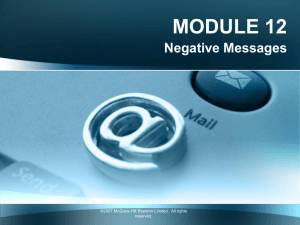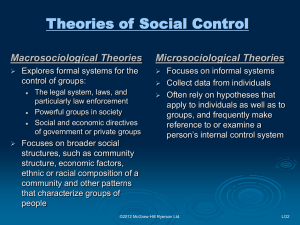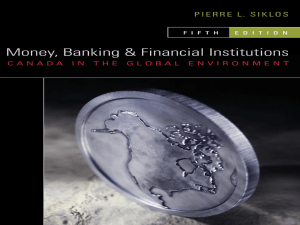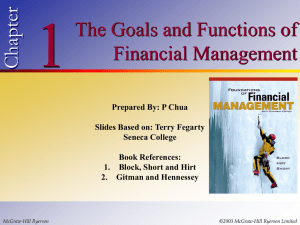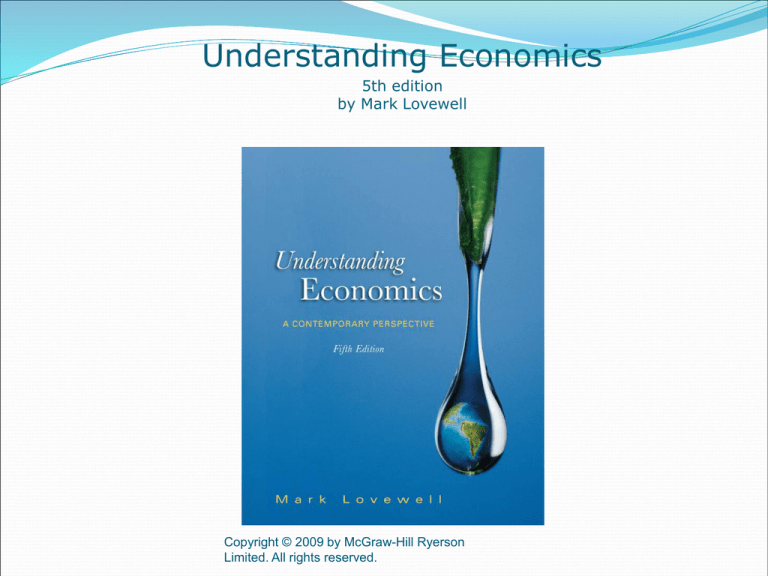
Understanding Economics
5th edition
by Mark Lovewell
Copyright © 2009 by McGraw-Hill Ryerson
Limited. All rights reserved.
Chapter 4
Costs of Production
Copyright © 2009 by McGraw-Hill Ryerson Limited. All rights reserved.
Learning Objectives
After this chapter you will be able to:
identify economic costs (explicit and implicit) of
production and economic profit
2. recognize short-run (total, average, and marginal)
products, and the law of diminishing marginal returns
3. derive short-run (total, average, and marginal) costs
4. explain long-run results of production (increasing returns
to scale, constant to scale, and decreasing to scale) and
long-run costs
1.
Copyright © 2009 by McGraw-Hill Ryerson
Limited. All rights reserved.
Types of Production
There are three main sectors in the economy:
the primary sector, which consists of industries that
extract or cultivate natural resources
the secondary sector, which consists of industries that
fabricate or process goods
the service sector, which consists of trade and
information industries
Copyright © 2009 by McGraw-Hill Ryerson
Limited. All rights reserved.
Productive Efficiency
Businesses can choose from different production
processes.
A labour-intensive process employs more labour and
less capital.
A capital-intensive process employs more capital and
less labour.
The lowest-cost process provides productive efficiency.
Copyright © 2009 by McGraw-Hill Ryerson
Limited. All rights reserved.
Economic Costs
Economic costs include:
explicit costs, which are payments to resource supplies
outside a business
implicit costs, which are what owners give up by being
involved in a business
Economic profit is found by subtracting economic
costs (both explicit and implicit) from total revenue.
Copyright © 2009 by McGraw-Hill Ryerson
Limited. All rights reserved.
Accounting versus Economic Profit
Accounting profit is total revenue minus explicit costs.
Because accountants consider only explicit costs,
accounting profit always exceeds economic profit by
the amount of the business’s implicit costs.
Copyright © 2009 by McGraw-Hill Ryerson
Limited. All rights reserved.
Production in the Short Run (a)
In the short run:
some inputs (such as capital) are fixed
other inputs (such as labour) are variable
Inputs are combined to make total product. Other
product measures include:
average product, which is total product divided by the
number of workers
marginal product, which is the extra total product
associated with an additional worker
Copyright © 2009 by McGraw-Hill Ryerson
Limited. All rights reserved.
The Law of Diminishing Marginal
Returns
Short-run production is determined by the law of
diminishing marginal returns. According to this law:
the addition of more variable input causes marginal
product to fall after some point
average product also falls after some point
Copyright © 2009 by McGraw-Hill Ryerson
Limited. All rights reserved.
Relating Average and Marginal
Values
Average and marginal values are related using three
rules:
If an average value is rising, then the marginal value
must be above the average value.
If an average value is falling, then the marginal value
must be below the average value.
If an average value stays constant, then the marginal
value must equal the average value.
Copyright © 2009 by McGraw-Hill Ryerson
Limited. All rights reserved.
Total, Marginal, and Average Products
Total
Product
(q)
(workers (T-shirts
per day) per day)
0
0
1
80
2
200
3
250
4
270
5
280
6
270
Marginal
Product
(Δq/ΔL)
(T-shirts
per day)
80
120
50
20
10
-10
Average
Product
(q/L)
(T-shirts
per day)
80
100
83.3
67.5
56
45
300
250
TP
200
150
100
50
0
--
1
2
3
4
5
6
Number of Workers Employed per Day
T-Shirts Produced per Day
Labour
(L)
T-Shirts Produced per Day
Figure 4.2, Page 96 and Figure 4.3, Page 98
Diminishing
returns set in
120
100
80
60
AP
40
20
0
-20
1
2
3
4
5
6
MP
Number of Workers Employed per Day
Copyright © 2009 by McGraw-Hill Ryerson
Limited. All rights reserved.
Costs in the Short Run
Short-run costs include:
fixed costs (costs of all fixed inputs)
variable costs (costs of all variable inputs)
total cost (fixed costs + variable costs)
Copyright © 2009 by McGraw-Hill Ryerson
Limited. All rights reserved.
Marginal Cost (a)
Marginal cost is the extra cost of producing another
unit of output.
It equals the change in total cost divided by the change
in total product.
The marginal cost curve is shaped like a “J” because of
the law of diminishing marginal returns.
Copyright © 2009 by McGraw-Hill Ryerson
Limited. All rights reserved.
Marginal Cost (b)
Figure 4.6, Page 101
12
MC
10
$ per T-Shirt
8
6
Diminishing
returns set in
4
2
0
50
100
150
200
250
300
Quantity of T-Shirts Produced Per Day
Copyright © 2009 by McGraw-Hill Ryerson
Limited. All rights reserved.
Per-Unit Costs
Per-unit costs include:
average fixed cost (fixed costs divided by total product)
average variable cost (variable costs divided by total
product)
average cost
either total cost divided by total product
or average fixed cost + average variable cost
Copyright © 2009 by McGraw-Hill Ryerson
Limited. All rights reserved.
Short-Run Costs for Pure ‘n’ Simple T-Shirts
Figure 4.5, Page 100
Labour
(L)
Total Marginal Fixed Variable
Product Product Costs Costs
(MP)
(q)
(FC)
(VC)
0
0
1
80
2
200
3
250
4
270
5
280
80
120
50
20
10
Average
Marginal Average
Average
Cost
Cost
Fixed Costs Variable
(AC)
(MC)
(AFV)
Costs
(ΔTC/Δq)
(FC/q)
(AVC) (AFC + AVC)
(VC/q)
Total
Cost
(TC)
(FC + VC)
$825
$0
$825
825
140
965
825
300
1125
825
425
1250
825
535
1360
825
640
1465
140
$1.75
160
1.33
125
2.50
110
5.50
105
10.50
Copyright © 2009 by McGraw-Hill Ryerson
Limited. All rights reserved.
$10.31
$1.75
$12.06
4.13
1.50
5.63
3.30
1.70
5.00
3.06
1.98
5.04
2.95
2.29
5.24
The Family of Short-Run Cost
Curves
Figure 4.7, page 103 12
MC
$ per T-Shirt
10
8
6
AC
b
4
AFC
AVC
2
a
0
50
100
150
200
250
300
Quantity of T-Shirts Produced Per Day
Copyright © 2009 by McGraw-Hill Ryerson
Limited. All rights reserved.
Returns to Scale (a)
All inputs can be changed by the same proportion in
the long run.
Increasing returns to scale means the % change in
output > the % change in inputs.
Constant returns to scale means the % change in output
= the % change in inputs.
Decreasing returns to scale means the % change in
output < the % change in inputs.
Copyright © 2009 by McGraw-Hill Ryerson
Limited. All rights reserved.
Returns to Scale (b)
Increasing returns to scale are caused by the division
of labour, specialized capital, or specialized
management.
Constant returns to scale arise whenever making more
of a product means repeating exactly the same tasks.
Decreasing returns to scale are caused by management
difficulties or limited natural resources.
Copyright © 2009 by McGraw-Hill Ryerson
Limited. All rights reserved.
Costs in the Long Run (a)
Long-run average cost is the minimum short-run
average cost at every output.
The long-run average cost curve is saucer-shaped
because of various ranges of returns to scale:
an initial range of increasing returns to scale
a middle range of constant returns to scale
a final range of decreasing returns to scale
Copyright © 2009 by McGraw-Hill Ryerson
Limited. All rights reserved.
Costs in the Long Run (b)
Figure 4.8, page 106
Long-Run Average Costs
AC4
$ per Magazine
AC1
AC2
Range A
AC3
Range B
Quantity of Magazines per Week
Copyright © 2009 by McGraw-Hill Ryerson
Limited. All rights reserved.
Range C
Long-Run AC
Costs in the Long Run (b)
Figure 4.9, page 107
Possible Long-Run Average Costs
Extended Range of
Decrease Returns
to Scale
Extended Range of
Constant Returns
to Scale
Extended Range of
Increasing Returns
to Scale
Quantity of Output
Long-Run AC
Quantity of Output
Copyright © 2009 by McGraw-Hill Ryerson
Limited. All rights reserved.
$ per Unit
Long-Run AC
$ per Unit
$ per Unit
Long-Run AC
Quantity of Output
Critic of the Modern Corporation
John Kenneth Galbraith:
suggested that ownership and control are separated in
large corporations
argued that shareholders (the owners) give up control to
managers
held out the possibility that managers are more
interested in maximizing sales than in maximizing
profit
Copyright © 2009 by McGraw-Hill Ryerson
Limited. All rights reserved.
Measuring Business Performance (a)
(Online Learning Centre)
Economists and accountants differ in the way they
measure business performance.
For accountants, there are two main business records:
a balance sheet shows a business’s assets, or items that it
owns. It also lists a business’s liabilities, or items that it
owes, as well as owner’s equity, which is the owner’s
stake in the business
Copyright © 2009 by McGraw-Hill Ryerson
Limited. All rights reserved.
Measuring Business Performance (b)
(Online Learning Centre)
An income statement shows a business’s activities in a
given time period, incorporating total sales (or revenue)
and total expenses, which are its explicit costs.
One important explicit cost is depreciation, or the
reduction in the value of a business’s durable assets.
For these assets (excluding land), an annual
depreciation charge is included in the income statement
as an expense.
Copyright © 2009 by McGraw-Hill Ryerson
Limited. All rights reserved.
Income Statement
(Online Learning Centre)
Income Statement
(for the year 2001)
Total Sales
Expenses
Food
Fuel
Depreciation
Interest on loan
Total explicit costs
$50 000
$ 15 000
3 500
1 000
500
Total profit
Copyright © 2009 by McGraw-Hill Ryerson
Limited. All rights reserved.
$20 000
$ 30 000
Calculation of Economic Profit
(Online Learning Centre)
Total Revenue
$50 000
Explicit Costs
Food
Fuel
Depreciation
Interest on loan
Total explicit costs
$ 15 000
3 500
1 000
500
Implicit Costs
Owner’s wage
Normal profit
Total implicit costs
$ 25 000
3 000
$20 000
Economic Profit
Copyright © 2009 by McGraw-Hill Ryerson
Limited. All rights reserved.
$28 000
$ 2 000
Analyzing Canadian Stock Markets
(a) (Online Learning Centre)
The Toronto Stock Exchange (the TSX) is the third
largest in North America, behind the New York Stock
Exchange (NYSE) and NASDAQ (originally the
National Association of Securities Dealers Automated
Quotations system).
The TSX concentrates on shares of relatively large
companies in Canada.
Copyright © 2009 by McGraw-Hill Ryerson
Limited. All rights reserved.
Analyzing Canadian Stock Markets
(b) (Online Learning Centre)
All junior equities (i.e. shares of smaller companies) in
Canada trade on the TSX Venture Exchange, with
headquarters in Calgary, Alberta, and with offices in
Toronto, Vancouver, Winnipeg, and Montreal.
All derivatives in Canada trade on the Montreal
Exchange.
Copyright © 2009 by McGraw-Hill Ryerson
Limited. All rights reserved.
Chapter 4
The End
Copyright © 2009 by McGraw-Hill Ryerson Limited. All rights reserved.


